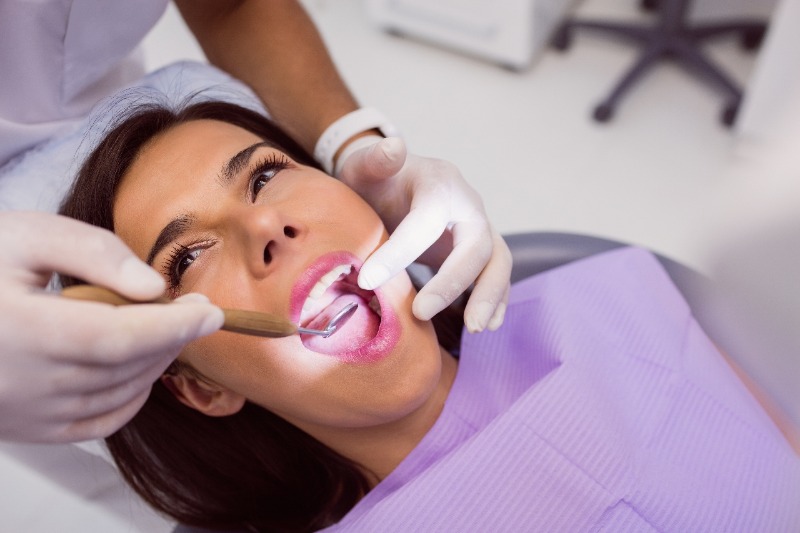Dental Cavities

A cavity is an inflammatory process of the hard tissues of the tooth. It is caused by bacteria and affects enamel and dentin. Every person during life faces this disease. If it does not stop its development, a cavity develops into pulpits. If you have signs of cavities of having pain, contact the best dentist in Burbank to make an appointment for an evaluation.
This entails severe pain, nerve removal, canal filling, and long-term treatment. Treatment of the cavity should begin as early as possible.
Please call 1-818-578-2332 for an appointment today.
What Are the First Signs of Dental Cavities?
The signs of cavities vary, depending on their location and extent. When tooth decay is just beginning, you may not have any symptoms at all. As the cavity gets larger, it may cause signs such as:
- Spontaneous pain when you bite down;
- Toothache;
- Tooth sensitivity;
- Visible holes in your teeth;
- White or black staining on any surface of a tooth;
What Leads to Tooth Decay?
Pathogenic microorganisms are always present in the mouth of any person. If the person is healthy and there is not enough of them, then they do not cause any diseases. But as soon as favorable conditions appear, bacteria begin to multiply actively and affect dental tissues.
Here are some reasons that provoke the beginning of cavity processes:
- Inadequate oral hygiene;
- Abnormal bite;
- Unbalanced diet, poor in vitamins and micro-macro elements;
- The abundance of sweet, starchy products that cause increased acidity of saliva and adversely affect the enamel;
- The weakness of enamel;
- Hormonal and immune problems;
- Tooth injury.
What Are the Stages of Cavity Development?
A cavity begins with the demineralization of the inorganic part of the enamel.
It looks like a whitish spot on the surface of the crown. Usually, at this stage, the disease is not even diagnosed. The patient simply does not go to the Burbank dentist, because nothing bothers him or her.
Further, in the disease there are such stages:
- Superficial cavity. The visible destruction of enamel begins. The patient notes pain while brushing the teeth or eating very cold or hot foods;
- Average cavity. The inflammatory process goes to dentin. This is the main tissue of the tooth, located under the enamel, and not so hard. Food residues often enter the inside of the cavity and cause severe pain;
- Deep cavity. At this stage, the inflammation affects almost the entire thickness of the dentin. Only a thin layer remains between the dentin and the pulp. The pathological process can affect soft tissues, causing pain to occur spontaneously. The main feature of the deep cavity is that visually it is not always clearly visible. If you do not see the Burbank dentist at this stage, you are risking getting periodontitis.
How to Treat Dental Cavity?
In the early stages of cavities development, dental treatment is not difficult. The remineralization procedure allows for stopping a cavity in the white spot stage. The enamel is saturated with calcium and fluoride ions and it becomes much stronger. If the cavity has passed into a more serious stage, treatment of the cavity is required by a dental filling.
The treatment of all subsequent stages of the cavity consists of the following stages:
- Cleaning a tooth from plaque. With the help of special nozzles and abrasive pastes residues of microbial contamination are removed;
- After hygienic cleaning the real color of the enamel becomes visible. It is necessary to determine the shade as accurately as possible in order to select the identical color of the filling material;
- Anesthesia.
- Tooth isolation from saliva. It is necessary to keep the surface dry and sterile. The lifetime of the filling and the possibility of the disease relapse directly depend on this.
- Restoration of the sidewall of the tooth. For this, various wedges and dies are used;
- Treatment of the cavity with a gel with a high concentration of phosphoric acid. This is necessary for etching enamel and dentin so that the filling is better kept;
- Applying an adhesive layer. It provides better fixation between dental tissues and fillings.
- Placement into the cavity of the gasket. It ensures uniform contact of the material with the walls of the tooth, even after shrinkage;
- Directly filling;
- Grinding and polishing the fillings to make them smooth and shiny.
How Can You Prevent Dental Cavities?

Any disease is better to prevent than to cure. Here are a few points, the observance of which at times will reduce the risk of cavity:
- Brush your teeth at least twice a day, for 2-3 minutes;
- After each meal uses a rinse.
- Use proven, fluoride-containing toothpaste.
- If plaque or stone forms, go to a dental office for professional cleaning.
- Limit in your diet carbohydrate foods, especially sweet and bakery products, sour fruits, and juices. Focus on coarse food and vegetables;
- Do not drink very cold or very hot drinks. The such temperature drops cause micro-cracks in the enamel, each of which can develop into a cavity;
- Burbank dentist, Dr. Sahakyan recommends visiting the dentist twice a year to identify possible diseases in the early stages.
If you follow all the recommendations of dentists for prevention, in most cases, the cavity can be recognized at an early stage. The cavity can be prevented, without leading to the appearance of holes in the teeth. Please call 1-818-578-2332 or contact our dental office today to make an appointment.


